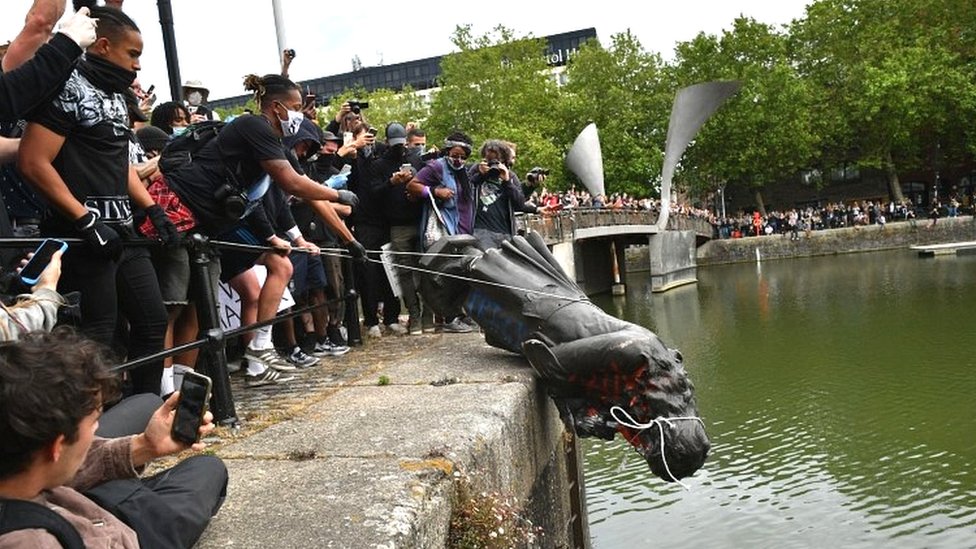by Emily Katzenstein
Recent years have seen successive waves of “statue wars”[1]—intense controversies over the visible traces of European colonialism in built commemorative landscapes. The most recent wave of controversies about so-called “tainted” monuments[2]—monuments that honour historical figures who have played an ignominious role in histories of slavery, colonialism, and racism—occurred during the global wave of Black Lives Matter protests that started in reaction to the murder of George Floyd in the summer of 2020. During a summer of global discontent, demonstrators famously toppled statues of Jefferson Davis (Richmond, Virginia), and Edward Colston (Bristol), beheaded a Columbus statue (Boston), and vandalised statues of King Leopold II (Antwerp, Brussels, Ghent), Otto von Bismarck (Hamburg), Winston Churchill (London), and James Cook (Melbourne), to name just a few examples.
These spectacular events sparked heated public debates about the appropriateness and permissibility of defacing, altering, or permanently removing “contested heritage”.[3] These public debates have also led to a renewed interest in questions of contested monuments and commemoration in political theory and political philosophy.[4] So far, however, this emergent debate has focused primarily on normative questions about the wrong of tainted commemorations and the permissibility of defacing, altering, or removing monuments.[5] Engagement with the political-sociological and aesthetic dimensions of monuments, monumentality, and commemoration, including their relationship to political ideologies and subjectivities, by contrast, has remained relatively thin in recent debates about commemoration and contested monuments in political theory. This means that crucial questions about the role of commemorative landscapes in political life and in the constitution of political subjectivities have remained underexplored. For example, there has been only a relatively superficial reconstruction of the ideological stakes of the debate over the fate of contested colonial monuments. Similarly, while there have been several powerful defences of vandalising and defacing “tainted commemorations,”[6] the literature in political theory and political philosophy has not yet engaged fully with innovative aesthetic strategies for contesting colonial monuments through decolonising artistic practices. This series, Contested Memory, Contesting Monuments, seeks to curate a space in which emergent debates about monuments and commemoration in political theory can be in conversation with debates about the politics of the built commemorative landscape in political science, anthropology, sociology, and area studies that explore political-sociological and aesthetic dimensions of monuments and commemoration. Importantly, it also seeks to facilitate a direct exchange of perspectives between scholars of monuments and commemoration in the academy, on the one hand, and memory activists and artists who are actively involved in today’s politics of memory and monuments, on the other. This is intended to be an open-ended series but we start with a wide-ranging series of inaugural contributions. In the first contribution to the series, Moira O’Shea traces the history of contesting Confederate monuments in the US and reflects on our relationship to the past. Upcoming contributions include an interview with Yolanda Gutierrez, a Mexican-German performance artist, and the founder of Bismarck Dekolonial, in which we discuss the realities of attempting to decolonise the built environment through artistic interventions; Chong-Ming Lim’s exploration of vandalising tainted commemorations; Sasha Lleshaj’s Sound Monuments, which reflects on very idea of monumentality, and connects struggles over ‘contested heritage’ to political contestations of ‘soundscapes’; and Tania Islas Weinstein and Agnes Mondragón analyses of the political uses and abuses of public art in contemporary Mexican politics. [1] Mary Beard, "Statue Wars," Times Literary Supplement, 13.06.2020 2015. [2] Chong‐Ming Lim, "Vandalizing Tainted Commemorations," Philosophy & Public Affairs 48, no. 2 (2020). [3] Joanna Burch-Brown, "Should Slavery's Statues Be Preserved? On Transitional Justice and Contested Heritage," Journal of Applied Philosophy 39 no. 5 (2022). [4] Helen Frowe, "The Duty to Remove Statues of Wrongdoers," Journal of Practical Ethics 7, no. 3 (2019); Johannes Schulz, "Must Rhodes Fall? The Significance of Commemoration in the Struggle for Relations of Respect," Journal of Political Philosophy 27, no. 2 (2019); Burch-Brown, "Should Slavery's Statues Be Preserved? On Transitional Justice and Contested Heritage."; Lim, "Vandalizing Tainted Commemorations."; Macalester Bell, "Against Simple Removal: A Defence of Defacement as a Response to Racist Monuments," Journal of Applied Philosophy 39 no. 5 (2021). [5] Daniel Abrahams, "Statues, History, and Identity: How Bad Public History Statues Wrong," Journal of the American Philosophical Association, First View , pp. 1 - 15 (2022). [6] Bell, "Against Simple Removal: A Defence of Defacement as a Response to Racist Monuments."; Ten-Herng Lai, "Political Vandalism as Counter-Speech: A Defense of Defacing and Destroying Tainted Monuments," European Journal of Philosophy 28, no. 3 (2020); Lim, "Vandalizing Tainted Commemorations." Comments are closed.
|
Details
Archives
May 2023
Categories
All
|

 RSS Feed
RSS Feed